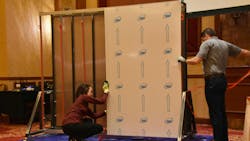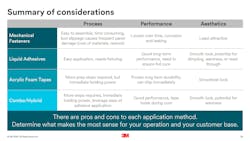Side wall attachment: Choosing the right method, material
Process, performance, and aesthetics—or how do trailer manufacturers want to build their products, how are their trailers going to be used, and what should they look like? That’s how a team from 3M compared a range of cargo trailer side wall attachment methods during a demonstration at the NATM convention.
Mechanical fasteners remain the most common manufacturing and assembly method, and the method is often used because “it’s the most familiar,” explained Julia Poppe, an application engineer with 3M and a member of the NATM technical committee.
“It’s fairly easy to train operators and the cost of materials is very, very small,” Poppe said. “This method is very quick—there is no waiting for any adhesive to cure or to reach full strength. The screw doesn’t care how dirty your panel is, or if your posts are aligned. The application also is not swayed based on the temperature or the humidity in your shop.”
Read more: NATM 2024 convention delivers training, solutions
Manufacturing can be loud, however, and screws are not recommended for aluminum trailers. The panel load is focused on those few points where the fasteners are in place, and there is often friction and corrosion, along with “dimpling.” Additionally, screws can work loose. Finally, applying graphics or a wrap is more challenging when working around rivets.
The use of liquid adhesives is the least common assembly method, Poppe continued. While the application is easy, a fixture has to be used to hold the panel in place on the frame while the adhesive cures. Among its advantages is that this method does not require holes in the panel, and therefore eliminates water intrusion. Liquid adhesives do require surface prep, however, and the cure can be impacted by the environmental conditions in the shop. And the assembler can’t be sure the bond, which is not visible, is as firm as it needs to be.
A third method, acrylic foam tape, is “one of the cooler technologies to hit the assembly world in a long time,” suggested Josh Dunn, advanced training manager at 3M. And to prove the point, the 3M team assembled a trailer wall during the presentation. While the compounds may vary, the advantage of acrylics is their flexibility, Dunn explained. Unlike the visible stress concentration of mechanical fasteners, tapes act as a “suspension system” that stretches with the panels as the trailer rolls down the road.
“The frame behind the panels is moving at a different rate, so this is actually absorbing all those stresses across that entire frame where the tape or the adhesive is binding the metal paneling,” Dunn said.
Test simulations have shown no delamination after 100,000 miles for acrylic tapes, versus screws that fail in 36,000 miles, Dunn added. The method also makes for a quieter trailer, as the tape absorbs vibrations.
In terms of assembly advantages, the 3M team pointed out that acrylic foam tape can be applied to the post and staged before the frame is welded for improved manufacturing throughput.
As for limitations, tapes require some surface prep and operator training on the process, application temperature should be above 50 degrees Fahrenheit, and an unconstrained top-rail resign is recommended.
Finally, a combination or hybrid method leverages benefits of tape and adhesive, as tape holds the panel in place while the adhesive cures, allowing for immediate shipment after assembly. However, using the two different methods often requires additional training.
Indeed, the key is to make the attachment method and materials align with the assembly process.
“Anyone can walk into an account and sell a roll of tape, or a tube of glue. Well, not everyone can walk into an account and sell that process to go with it,” Dunn said. “You can buy the best acrylic foam tape in the world but, if your process is broken, that’s not going to work. You can buy the best sealants in the entire world but, if your process is broken, it’s not going to work. So it’s really, really important that we make sure we’re maximizing the process.”
About the Author
Kevin Jones
Editor
Kevin has served as editor-in-chief of Trailer/Body Builders magazine since 2017—just the third editor in the magazine’s 60 years. He is also editorial director for Endeavor Business Media’s Commercial Vehicle group, which includes FleetOwner, Bulk Transporter, Refrigerated Transporter, American Trucker, and Fleet Maintenance magazines and websites.
Working from Beaufort, S.C., Kevin has covered trucking and manufacturing for nearly 20 years. His writing and commentary about the trucking industry and, previously, business and government, has been recognized with numerous state, regional, and national journalism awards.


